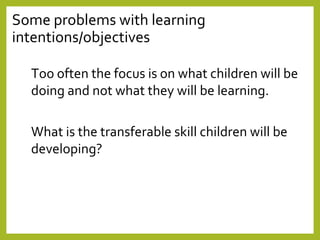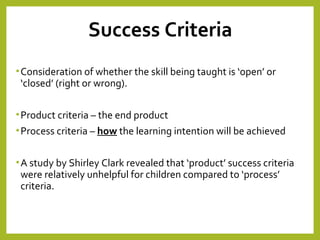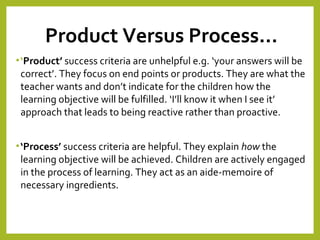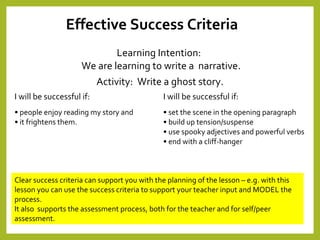Dev expert
- 1. Preparing for Success in School Developing Practice:Teachers’ Standard 4 To plan and teach well structured lessons
- 2. Outline and Aims To review your areas of strength and consider aspects for further development in relation to setting clear learning intentions and success criteria To consider the principles of formative assessment; Learning Intentions Learning Outcomes / Success Criteria How this links to pupil learning and assessment
- 3. •What is a learning intention? • What should an effective learning intention do? •A learning intention describes what pupils should know, understand or be able to do by the end of the lesson or series of lessons.’ (Learning Unlimited, 2004)
- 4. We are all familiar with using learning intentions. However some of us use different terms for them, including: learning objectives, learning goals, or learning aims. • In AfL, the word intention is used purposely because it puts greater emphasis on the process of learning rather than the end product. • A learning intention is simply a description of what you want the pupils to know, understand or be able to do by the end of a lesson. What is the focus? • It identifies new learning for the pupils and it focuses on transferable skills, so pupils can make connections between their learning and other areas of school and life, take the learning away and apply it in other contexts. • A key issue for student teachers is that they confuse the learning intention with the task.
- 5. Some Key Principles: Sharing Learning Intentions o Identify what pupils will be learning (new skills/ transferrable skills) e.g We are learning to……. o Explain the reason for the learning (This is because…) o Share the learning and the reason with pupils at the beginning of the lesson or activity. o Present these in language that pupils can understand. o Revisit the learning intention throughout the activity/lesson.
- 6. Reflect on placements and the feedback you received How systematic have you been in doing this – particularly at the beginning of a lesson or activity? Are you writing learning intentions in language that pupils can understand? When you have presented learning intentions, have we tended to focus on what will be produced rather than what will be learned?
- 7. Key steps to framing and delivering learning intentions • Be clear and specific about learning intentions and the reasons why these are important things to learn • Break down learning intentions and translate them into meaningful and manageable language • REMEMBER THE IMPORTANCE OF USING CHILD-FRIENDLY LANGUAGE • Introduce and share learning intentions appropriately at beginning of the lesson. • Structure lessons so the pupils can focus on and revisit the learning intention through approaches such as questioning, peer- and self- assessment, written and oral feedback and plenary sessions.
- 8. Some problems with learning intentions/objectives Too often the focus is on what children will be doing and not what they will be learning. What is the transferable skill children will be developing?
- 9. Learning Intention or Context? Before After L.I muddled with context L.I Context To be able to write a version of Little Red Riding Hood. To write a version of a traditional text Little Red Riding Hood To write about a journey I have had. To write a recount. A journey A school visit to Holy Island. To describe a friend. To create an effective characterisation My friend
- 10. When stating the Learning Intention explain what children will be learning, do not just focus on what they will be doing. •Learning Intention: What are we learning? To write an effective characterisation. •NOT (Activity) What are we doing? Write a description of your best friend.
- 11. ACTIVITY:Writing Learning Intentions Activity Learning Intention Context Give a speech for or against smoking To present a point of view in a persuasive way Speech about smoking Draw a bar chart to show how pupils in our class come to school To present information graphically Bar chart on types of transport used to get to school Work effectively in a group to design a leaflet to promote healthy eating To be able to work effectively in a group Healthy eating leaflet Reflect upon your learning intentions from your second placement…
- 12. Success Criteria •Consideration of whether the skill being taught is ‘open’ or ‘closed’ (right or wrong). •Product criteria – the end product •Process criteria – how the learning intention will be achieved •A study by Shirley Clark revealed that ‘product’ success criteria were relatively unhelpful for children compared to ‘process’ criteria.
- 13. Product Versus Process… •‘Product’ success criteria are unhelpful e.g. ‘your answers will be correct’. They focus on end points or products. They are what the teacher wants and don’t indicate for the children how the learning objective will be fulfilled. ‘I’ll know it when I see it’ approach that leads to being reactive rather than proactive. •‘Process’ success criteria are helpful. They explain how the learning objective will be achieved. Children are actively engaged in the process of learning. They act as an aide-memoire of necessary ingredients.
- 14. Success Criteria Product Success Criteria: Learning Intention: To use papier-mâché effectively Success Criterion: Everyone will have made a bowl Process Criteria: Learning Intention: To use papier-mâché effectively Success Criteria: I will remember to: •Tear up the paper •Cover it with the paste •Smooth it around the balloon evenly
- 15. Effective Success Criteria… • are linked to the learning intention • are specific to an activity • are discussed and agreed with pupils prior to undertaking the activity • must be visible so children can look up and check during the lesson • provide a scaffold and focus for pupils while engaged in the activity • are used as the basis for feedback and peer-/self-assessment
- 16. Learning Intention: We are learning to write a narrative. Activity: Write a ghost story. I will be successful if: • people enjoy reading my story and • it frightens them. I will be successful if: • set the scene in the opening paragraph • build up tension/suspense • use spooky adjectives and powerful verbs • end with a cliff-hanger Effective Success Criteria Clear success criteria can support you with the planning of the lesson – e.g. with this lesson you can use the success criteria to support your teacher input and MODEL the process. It also supports the assessment process, both for the teacher and for self/peer assessment.
- 17. Experiment with writing process based success criteria to support children achieving the learning objective We are learning to… present an argument. We are learning to… calculate the passing of time in 5-minute intervals.
- 18. Possible examples We are learning to… present an argument. We are learning to… calculate the passing of time in 5-minute intervals. Remember to… • include opening and closing statements • give reasons for and against • use evidence to support • use language to persuade Remember to… • count from the minute hand • stop where the minute hand finishes • count in fives • go clockwise
- 19. Effective Process Success Criteria Effective criteria will: • Be written to support understanding • Include examples • Be short • Be clearly laid out and visible • Relate to the learning and not the task Effective use will be when pupils: Know their purpose Use to: - support learning - act as a reminder Use as a check-list
- 20. How does all this support children’s learning and progress? Knowing what is required to meet the learning intention helps learners to: • Keep track of what has been done and what still needs to be done • Know the expectation of the teacher • Start to self evaluate against the criteria, seeking help where needed (“this bit was fine…, this bit I’m not quite sure about…, because…”) • Be in a position to mark their own work or co-operate with a response partner • Confidently work with others who share the same criteria
- 21. Assessment: Grading Against the Standards
- 22. Bibliography • Clarke (2005) Formative Assessment in Action – Weaving the Elements Together • Clarke (2003) Enriching Feedback in the Primary Classroom • Black (2003) Assessment for Learning – Putting it into Practice
Editor's Notes
- Common terms used in schools.
- Here are some examples of learning intentions. Look at the second example. What curricular context does it come from? (could come from any subject) Is it a useful skill to have in any context?
- Here are some further examples of the learning intention muddles with the task / context. An easy way to help is to consider in two parts – what is the learning intention and what is the context.
- Often students (and teachers) confuse the learning intention with the task. In this example, pupils are learning to write effective characterisations.. When defining learning intentions, the key is to distinguish between what your pupils are learning and what they are doing. It sounds simple enough, but many of us get it wrong. For instance, who here can hear themselves saying something along the lines of: ‘Today class, you’re going to write a description about your best friend’ instead of ‘Today class, you’re going to be learning how to write effective characterisations.’ The first statement focuses on what they’ll be doing in the activity … but the second explains what they’ll be learning. And this is the critical difference when identifying learning intentions. We need to emphasise what the pupils will be learning.
- ACTIVITY: Look at the following activities – consider the Learning Intentions for these activities. What could the context be? The blue box can be revealed to show some possible answers.
- When setting the success criteria you need to consider whether the outcome is a closed skill or an open skill. Closed skills are either right or wrong. They have easily planned success criteria – either the steps involved or what you need to remember to do in order to achieve the learning objective. Open skills are neither right or wrong – these are the lesson objectives which need examples and discussion about quality, using real examples as a model. The success criteria in this case is usually like a set of ingredients – giving children a menu of devices that they could use. The idea of process success criteria concerns giving the child a reminder of steps or ingredients to support the child achieving the learning objective. Planning the success criteria makes planning the lesson / activity easier because the criteria forms the essential ingredients which need to be modelled and taught in the lesson. Once children have access to the sucess criteria it also provides them with a framework for formative dialogue and enables them to: Clarify understanding Identify success Discuss strategies for improvement Reflect on overall progress
- Small group activity.
- Quality success criteria are characterised by these features: They are closely linked to the learning intention. They are specific to the activity and will vary with each activity, even if the activities share a common learning intention. They are agreed with the pupils in advance. This discussion aspect is particularly important in the classroom. First, it helps foster a positive classroom environment. It also gets pupils involved in the learning and upcoming activity even before it’s begun. It can also help build pupil self-esteem by offering them opportunities to contribute. And it is a useful tool to strengthen the pupil-teacher relationship. They encourage responsibility and independence by scaffolding peer- and self-assessment. They are revisited and used to provide pupils with feedback on their learning. This feedback can be provided by both you and the pupils themselves. Remember to follow through, though, and only assess the pupils on what has been agreed. A mistake many make is also commenting on other aspects – this could be seen as moving the goal posts.
- In small groups, can you write 3-4 PROCESS focussed criteria for these 2 tasks.





















